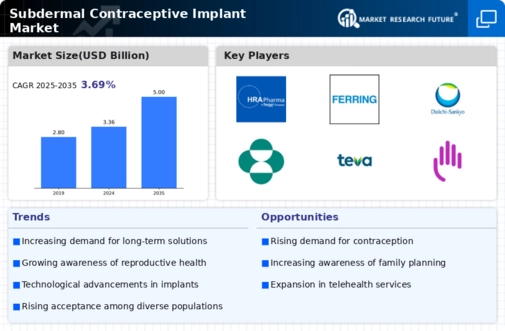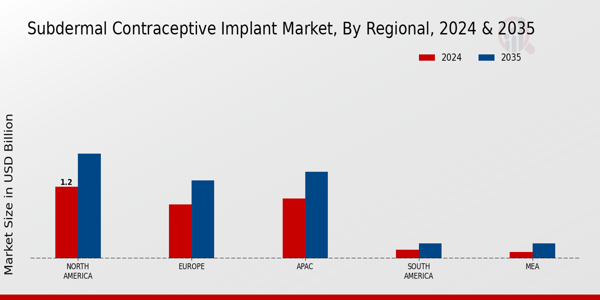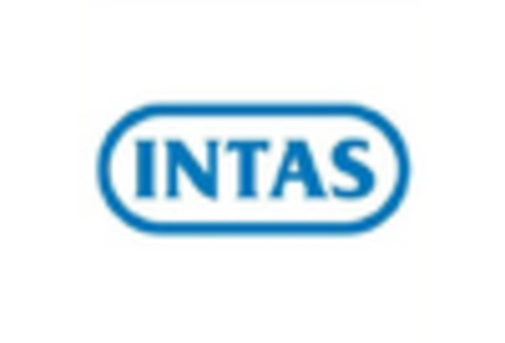Market Growth Projections
The Global Subdermal Contraceptive Implant Market Industry is projected to experience robust growth over the next decade. With a market value of 3.36 USD Billion in 2024, it is expected to reach 5 USD Billion by 2035, indicating a strong upward trajectory. The anticipated compound annual growth rate (CAGR) of 3.68% from 2025 to 2035 further underscores the market's potential. This growth is driven by various factors, including increasing demand for long-acting contraceptives, government support, and advancements in technology. As the market evolves, stakeholders are likely to explore new opportunities to enhance accessibility and improve user experience.
Government Initiatives and Funding
Government initiatives play a crucial role in promoting the Global Subdermal Contraceptive Implant Market Industry. Many countries are implementing policies to enhance access to contraceptive methods, particularly in underserved populations. For instance, various health departments are allocating funds to subsidize the cost of subdermal implants, making them more accessible. These initiatives are often part of broader public health strategies aimed at reducing unintended pregnancies and improving maternal health. As a result, the market is expected to grow steadily, with projections indicating a market value of 5 USD Billion by 2035, driven by sustained government support and funding.
Increasing Awareness and Education
Increasing awareness and education regarding reproductive health significantly bolster the Global Subdermal Contraceptive Implant Market Industry. Educational campaigns aimed at both healthcare providers and potential users are crucial in dispelling myths and misconceptions surrounding contraceptive implants. As individuals become more informed about the benefits and effectiveness of subdermal implants, the likelihood of adoption rises. This trend is particularly evident in regions where educational outreach programs are implemented, leading to higher acceptance rates. Consequently, the market is poised for growth, as informed consumers are more likely to choose subdermal implants as their preferred contraceptive method.
Shifting Societal Norms and Attitudes
Shifting societal norms and attitudes towards family planning and women's health contribute to the growth of the Global Subdermal Contraceptive Implant Market Industry. As societies evolve, there is a growing acceptance of contraceptive use, particularly among younger generations. This cultural shift encourages women to take control of their reproductive health, leading to increased demand for effective contraceptive methods like subdermal implants. Furthermore, the normalization of discussions around contraception in various media channels fosters a supportive environment for women to seek out these options. This evolving landscape is likely to sustain market growth in the coming years.
Rising Demand for Long-Acting Contraceptives
The Global Subdermal Contraceptive Implant Market Industry experiences a notable increase in demand for long-acting reversible contraceptives (LARCs). This trend is driven by growing awareness of family planning and reproductive health. As women seek effective and convenient contraceptive options, subdermal implants, which provide protection for up to three years, become increasingly appealing. In 2024, the market is projected to reach 3.36 USD Billion, reflecting a shift in preference towards LARCs. This shift is particularly pronounced in developing regions, where access to healthcare services is improving, thereby enhancing the adoption of subdermal implants.
Technological Advancements in Implant Design
Technological advancements significantly influence the Global Subdermal Contraceptive Implant Market Industry. Innovations in implant design, such as the development of biodegradable materials and improved delivery systems, enhance the efficacy and safety of these contraceptives. These advancements not only increase user satisfaction but also reduce the risk of complications associated with traditional methods. As a result, healthcare providers are more likely to recommend subdermal implants, contributing to market growth. The anticipated compound annual growth rate (CAGR) of 3.68% from 2025 to 2035 reflects the positive impact of these technological improvements on the overall market.
























Leave a Comment